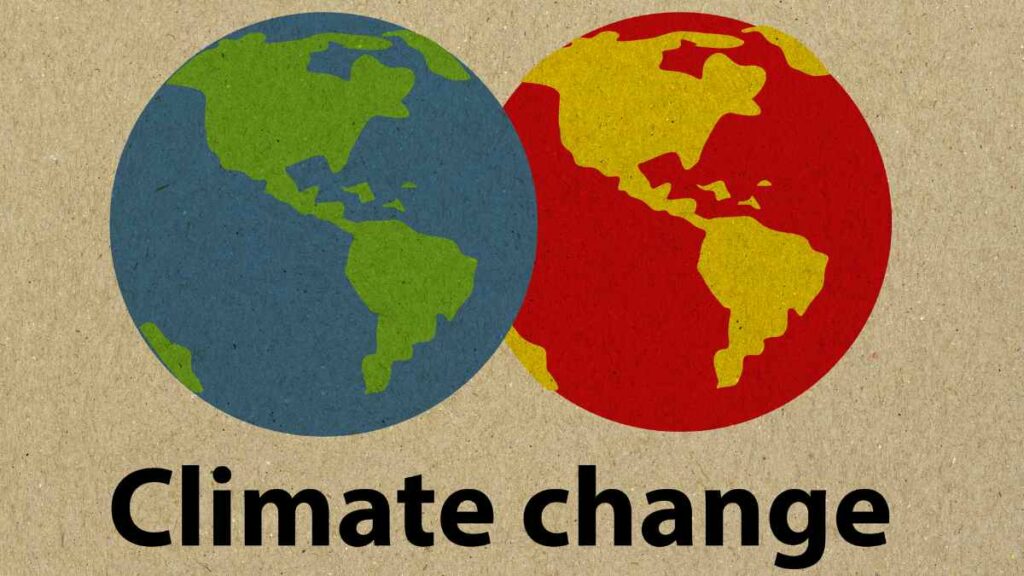Are you feeling anxious about the current state of the environment?
If so, you’re not alone.
Climate change anxiety is an increasingly common emotion among people of all ages as the effects of climate change become more and more visible.
This article will explore some common signs of climate anxiety and tips for managing your feelings about the environment.
So let’s get started!
Definition of Climate Anxiety

What is climate anxiety? Have you ever found yourself in a situation or conversation where you feel overwhelmed, helpless or powerless in the face of the climate crisis?
If so, you may be experiencing symptoms of anxiety from the current climate challenges.
Climate anxiety is the fear, stress, and anxiety experienced in response to the climate crisis. It can be brought on by events such as natural disasters, worrying news headlines, or even just having conversations with friends and family about the state of our planet.
-

Fashionably Green and On-The-Go
£16.50 Select options This product has multiple variants. The options may be chosen on the product page -

Reusable and Ready Eco-Friendly Tote Bag
£16.50 Add to cart
It’s normal to feel anxious facing such a large, complex, and urgent problem.
But, although it can be crippling, climate anxiety can also be an incredibly powerful emotion. It can motivate us to take action and inspire us to make changes in our lives that can positively impact the planet.
It can also help us to come together as a global community to demand action from our governments and leaders.
So, although it might be difficult to cope with at times, it’s important to re-route feelings and use them as a source of strength and motivation. After all, it can push us to work together to create the future we all want to see.
Reasons for Increasing Anxiety

Even the most optimistic among us can’t deny that climate change’s effects are becoming more difficult to ignore.
With extreme weather events becoming more common, rising sea levels, and worsening air quality, it’s understandable why so many people are feeling anxious about the future of our planet.
Here are a few of the major reasons why climate anxiety is increasing:
- The increasing frequency and intensity of extreme weather events: As the planet warms, we see more extreme weather events. From heat waves and floods to droughts and wildfires, climate change’s effects are becoming more apparent. This has led to a massive increase in the number of people feeling anxious about the future of our planet. A recent survey showed that over 50% of people have symptoms of anxiety relating to the climate.
- The predicted impacts of climate change are becoming more dire: With each passing day, the predictions of what climate change will bring become more dire. From sea level rise to drastic changes in the global economy, the predictions of what is to come have caused many to feel helpless and hopeless.
- The lack of action from governments and corporations: Despite the dire predictions of climate change, governments and corporations have been slow to take action. This has made many feel like the problem is not being taken seriously enough and that we are doomed to face the consequences of our inaction.
- The feeling of being overwhelmed: With so many huge and pressing issues, it can be hard to know where to start when taking action. This can lead to a feeling of being overwhelmed, which only increases the sense of anxiety.
- The feeling of guilt: Many of us feel guilty for contributing to the problem, whether it be through our lifestyles and consumption habits or our inaction. This guilt can lead to overwhelming anxiety about our and the planet’s future.
We all have a role to play in fighting climate change, and it’s up to us to take the necessary steps to ensure our planet is safe for future generations.
Physical & Mental Health Impacts of Climate Anxiety
Changes in Eating Habits

The world is changing and with it, so are our eating habits. We’re becoming more conscious about our carbon footprint and the effects of climate change on our planet. While some of us are already taking the initiative to reduce our impact on the environment, many of us are becoming increasingly anxious about the changes in our climate.
But this doesn’t mean we must stop eating the foods we love. In fact, there are plenty of changes we can make to our diets to help lessen our impact on the environment while still enjoying delicious meals.
Here are some of the ways you can start eating better and reduce your climate anxiety at the same time.
First, start by reducing your consumption of meat. Eating less meat means less animal farming, which is a major contributor to global warming. You can still enjoy tasty meals without meat—try some delicious vegan and vegetarian recipes to get you started.
You can also make a conscious effort to buy locally-sourced, seasonal food. Not only will this reduce your carbon footprint, but it will also support local farmers, which is a win-win!
Another change you can make is to opt for more plant-based proteins. Plant-based proteins are much more sustainable and will help you reduce your carbon emissions. Try delicious recipes like veggie burgers, veggie tacos, or even a vegan stir-fry.
Finally, be sure to properly dispose of your food waste. Composting is a great way to turn food scraps into nutrient-rich soil that can be used to grow healthy, organic produce.
Small changes to our diets can make a big difference in our climate anxiety. Try implementing simple habits to start eating better and reducing your carbon footprint.
Sleep Disturbances

Getting a good night’s sleep can be difficult when you’re worried about the world’s future. But don’t worry, there are ways to combat this problem.
The first step is to identify the cause of your sleep disturbances.
Is it the news? Social media? Is it the feeling of helplessness when it comes to the climate crisis?
Once you’ve identified the source, it’s time to take action. If the news makes you anxious, try limiting your news consumption. Spend less time scrolling through social media and more time taking action.
If you feel overwhelmed or helpless, try to focus on things you can control. Take up a hobby that helps you relax, like gardening or painting. Make sustainable swaps to reduce your carbon footprint and feel like you are making a difference.
Try some relaxation and calming techniques before bed. Take a warm bath, practice deep breathing, or meditate for a few minutes. Play some soothing music or listen to an audiobook. These all help to create a peaceful environment and ease your mind before you turn in for the night.
If all else fails, you should seek guidance from a registered medical expert.
Stress & Anxiety

Climate anxiety can be a source of immense stress and anxiety, making us feel powerless and trapped in a situation we can’t control.
It’s easy to feel overwhelmed and helpless regarding climate change. But we can’t let it paralyze us. The key to coping with climate anxiety is to focus on the actions we can take to help rather than the problems we can’t solve.
Take deep breaths, find moments to relax, and reach out for help when needed. There are many things you can do to reduce your stress and anxiety about climate change.
- Educate yourself on living a more eco-friendly life, read up on the latest climate science and stay informed. This will help you find solutions and stay motivated.
- Get involved in your community. You can volunteer with local organizations to help spread awareness and fight for climate justice. You can also support green businesses and products that reduce their carbon footprints.
- Find ways to help nature. Plant trees, switch to a plant-based diet, or participate in beach clean-ups. Even small actions like reusing and recycling are important ways to reduce your carbon footprint.
- Take care of yourself. Find ways to reduce stress and relax your mind. Spend time outdoors, meditate, practice yoga, and surround yourself with friends and family who support you.
Climate anxiety can be overwhelming, but we can tackle it together.
Coping Strategies for Climate Anxiety
Practicing Mindfulness

As the climate crisis gains more attention, it can be overwhelming to think about the impact it may have on our future. It’s easy to become overwhelmed with fear, frustration, and sadness, but it’s important to remember that your mental health is just as important as the environment. Practicing mindfulness can help you stay present and calm even as the world changes.
One way to practice mindfulness with climate anxiety is to focus on breathing. Take slow, deep breaths and pay attention to how they feel as they move in and out of your body. Notice the rise and fall of your chest and how your belly expands and contracts with each breath. This can help to clear your mind and give you a sense of calm amidst all the chaos.
Another way to practice mindfulness is to tune into your senses. Notice the smells, sounds, and textures around you. Feel the warmth of the sun on your skin or the coolness of the breeze. Savoring the present moment can help to alleviate anxious thoughts about the future.
You can also practice mindfulness by engaging in activities that bring you joy. Whether it’s playing music, dancing, painting, or gardening, take some time out of your day to do something that is meaningful and brings you pleasure. This can help to reduce stress and connect you with the present moment.
Finally, practice mindfulness by acknowledging how you’re feeling without judgment. It’s normal to experience a range of emotions surrounding climate anxiety, so don’t be afraid to express them. Just remember to be kind to yourself and allow yourself to feel what you’re feeling.
Connecting with Nature

Connecting with nature is a great option if you’re looking for a way to cope with climate anxiety. Just a few minutes in the fresh air can help to calm you and shift your focus away from worrying thoughts.
One way to do this is to walk through a nearby park or nature area. Enjoy the sights and sounds of the environment and take some deep breaths to relax. Pay attention to the details around you – the smell of the trees, the sound of the birds chirping, the feeling of the grass under your feet. All these little details can help ease your worries and help remove the stress of climate anxiety.
You can also try gardening, bird watching, or even camping if you have the chance. Getting in touch with nature can be both a mental and physical activity, helping to reduce stress and tension in your body.
Finally, why not take the opportunity to learn more about the climate and the environment? Numerous websites, books, and podcasts provide great resources to explore the topic further.
Engaging in Positive Activism

If your heart is heavy from climate anxiety, turn your worry into positive activism! If you want to make a difference in the world, it’s time to take action. From organizing a local protest to signing petitions, there are plenty of ways to get involved.
Greta Thunberg has used activism to drive significant changes through the world’s most important governments.
Participating in an organized protest is one of the most popular forms of positive activism. Gather with like-minded individuals to voice your concerns and call for change. You can also get creative and host a rally or march with creative signs and chants. It’s amazing how powerful a group of people can be!
If you’re not one for public demonstrations, there are other ways to make your voice heard. Signing petitions, donating to environmental organizations, and writing to your local representatives are great ways to get involved.
You can also show your support through social media. Posting informative articles or stories about climate change will help spread awareness and encourage others to engage in positive activism.
Establish Eco-Friendly Routines

One of the best ways to counter feelings of helplessness is to create a routine that improves the environment and helps you manage and reduce your anxieties.
A consistent routine can help you stay focused on what you can do to make a difference rather than worrying about the things you can’t. Routine can help you create a structure to dedicate time to making small but impactful changes to your lifestyle.
Start by deciding on small changes you would like to make to reduce your impact on the climate. These could include reducing your transportation emissions, using less energy in your home, eating more sustainably, moving to a zero-waste lifestyle, or cutting down on your single-use plastic consumption.
Once you have identified these changes, try to incorporate them into your daily routine in some way.
Make them a habit!
For example, if you want to reduce your transportation emissions, make a point of walking or cycling to work or school instead of driving. If you want to reduce your energy consumption, try to unplug devices when they’re not in use and install energy-efficient lightbulbs in your home.
If you want to eat more sustainably, make a point of making changes to your grocery list, such as buying more locally-sourced foods. And if you want to cut down on your single-use plastic consumption, make a point of bringing your reusable bags and containers when shopping.
Routines like this will help keep you focused on what you can do to make a real difference in the climate crisis. They can also help to keep you motivated and give you a sense of accomplishment, which can help to reduce your feeling of helplessness.
Establishing a routine can also help you prioritize your well-being to look after your mental health while also doing your part to tackle the climate crisis.
Treat Underlying Conditions

Climate anxiety is a very real phenomenon that affects a growing number of people around the world. From worrying about the future to feeling powerless to make a difference, people with this condition can suffer from insomnia, depression, and other mental health issues. Fortunately, there are ways to treat underlying conditions related to climate anxiety.
If your anxiety gets to the point where it is overwhelming or crippling, please seek medical advice. A psychologist or therapist can provide a space to explore and process the emotional implications of climate change and offer guidance in developing coping strategies and managing stress.
Treating underlying conditions related to climate anxiety is essential to reduce anxiety symptoms and give people the tools to make a real difference in the fight against climate change.
From educating oneself to seeking professional help, there are ways to cope with climate anxiety and positively impact the planet.
Conclusion
Climate Anxiety is a growing phenomenon, and we must address our worries and concerns.
By talking about our fears and taking action to reduce our carbon footprints, we can start to make a difference and help protect our planet.
So let’s take a deep breath and do our part to create the future we want to live in.

